Deza M.M., Laurent M. Geometry of Cuts and Metrics
Подождите немного. Документ загружается.

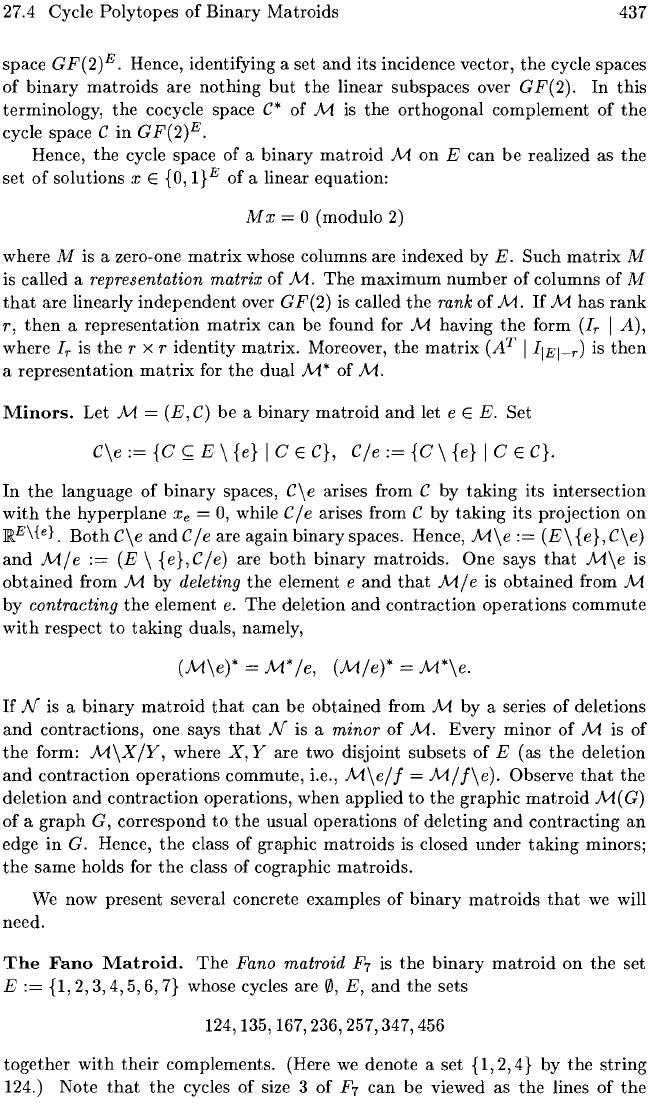
27.4 Cycle Polytopes
of
Binary
Matroids
437
space
GF(2)E.
Hence, identifying a set
and
its
incidence vector,
the
cycle spaces
of
binary
matroids
are
nothing
but
the
linear subspaces over
GF(2).
In
this
terminology,
the
cocycle space
C*
of M
is
the
orthogonal complement
of
the
cycle space C
in
GF(2)E.
Hence,
the
cycle space of a
binary
matroid
M
on
E
can
be
realized as
the
set
of
solutions I E
{O,
I}E
of
a linear equation:
M I = ° (modulo
2)
where M is a zero-one
matrix
whose columns are indexed by
E.
Such
matrix
M
is called a representation
matrix
of
M.
The
maximum
number
of
columns
of
M
that
are linearly
independent
over
GF(2)
is
called
the
rank
of
M.
If
M
has
rank
r,
then
a
representation
matrix
can
be found for M having
the
form
(IT
I
A),
where
IT
is
the
r x r
identity
matrix.
Moreover,
the
matrix
(AT
I IIEI-T) is
then
a
representation
matrix
for
the
dual
M*
of
M.
Minors.
Let M =
(E,
C)
be a
binary
matroid
and
let e E
E.
Set
C\e:={C<:;:E\{e}ICEC},
Cle:={C\{e}ICEC}.
In
the
language
of
binary
spaces,
C\e
arises from C by
taking
its intersection
with
the
hyperplane
Ie
=
0,
while C I e arises from C by
taking
its
projection
on
RE\{e}.
Both
C\e
and
Cle
are again
binary
spaces. Hence,
M\e
:=
(E\
{e},
C\e)
and
Mle
:=
(E
\
{e},Cle)
are
both
binary
matroids. One says
that
M\e
is
obtained
from M by deleting
the
element e
and
that
Mle
is
obtained
from M
by contracting
the
element
e.
The
deletion
and
contraction
operations
commute
with
respect
to
taking
duals, namely,
(M\e)*
=
M*
Ie,
(Mle)*
=
M*\e.
If
N is a
binary
matroid
that
can
be
obtained
from M by a series
of
deletions
and
contractions, one says
that
N is a
minor
of
M.
Every
minor
of
M is of
the
form:
M\XIY,
where
X,
Yare
two disjoint subsets
of
E (as
the
deletion
and
contraction
operations
commute, i.e.,
M\el
f =
MI
f\e).
Observe
that
the
deletion
and
contraction
operations,
when
applied
to
the
graphic
matroid
M(G)
of
a
graph
G, correspond
to
the
usual operations of deleting
and
contracting
an
edge
in
G. Hence,
the
class of graphic
matroids
is closed under
taking
minors;
the
same
holds for
the
class of cographic matroids.
We
now present several concrete examples
of
binary
matroids
that
we
will
need.
The
Fano
Matroid.
The
Fano matroid
F7
is
the
binary
matroid
on
the
set
E
:=
{I,
2,
3,
4, 5, 6,
7}
whose cycles are
0,
E,
and
the
sets
124,135,167,236,257,347,456
together
with
their
complements. (Here
we
denote a set
{I,
2,
4} by
the
string
124.) Note
that
the
cycles
of
size 3
of
F7
can
be viewed as
the
lines
of
the
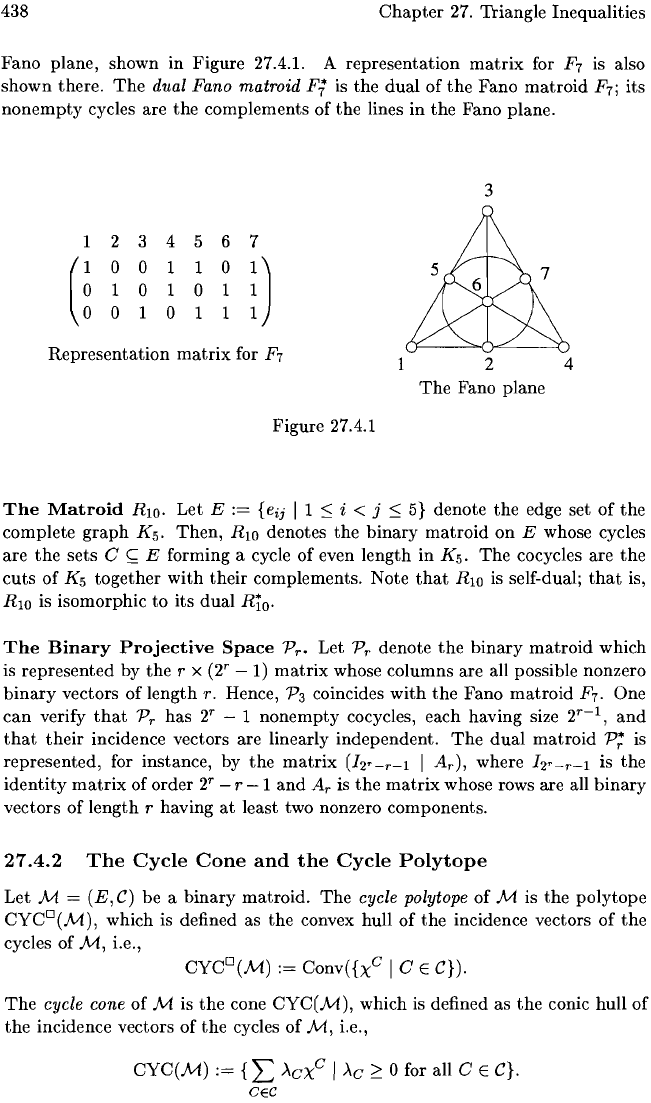
438
Chapter
27.
Triangle Inequalities
Fano plane, shown in Figure 27.4.1. A representation
matrix
for
F7
is
also
shown there.
The
dual Fano matroid
F;
is
the
dual of
the
Fano
matroid
F7;
its
nonempty cycles are the complements of the lines in the Fano plane.
3
1 2 3 4 5 6
7
(!
0 0 1 1 0
D
1
0
1
0
1
0
1
0 1 1
Representation
matrix
for
F7
2 4
The
Fano plane
Figure 27.4.1
The
Matroid
RlO. Let E
:=
{eij I 1
:s
i < j
:s
5}
denote the edge set of
the
complete
graph
K
5
.
Then, RlO denotes the binary
matroid
on E whose cycles
are
the
sets C
<;
E forming a cycle of even length in K
5
•
The
cocycles are
the
cuts
of
K5
together
with
their
complements. Note
that
RlO
is
self-dual;
that
is,
RlO is isomorphic to its dual Rio.
The
Binary
Projective
Space
PT. Let P
r
denote
the
binary
matroid
which
is represented by the r x
(2'
-1)
matrix
whose columns are all possible nonzero
binary
vectors of length
r.
Hence,
P3
coincides
with
the
Fano
matroid
F
7
•
One
can
verify
that
P
T
has
2T
- 1 nonempty cocycles, each having size 2
T
-
1
,
and
that
their
incidence vectors are linearly independent.
The
dual
matroid
P;
is
represented, for instance, by
the
matrix
(12
r
-,-1
I A
r
),
where
hr-r-1
is
the
identity
matrix
of order
2T
- r
-1
and
AT
is
the
matrix
whose rows are all
binary
vectors of length r having
at
least two nonzero components.
27.4.2
The
Cycle
Cone
and
the
Cycle
Polytope
Let M =
(E,
C)
be
a binary matroid.
The
cycle polytope of M is
the
polytope
CYCD(M),
which is defined as the convex hull of the incidence vectors of
the
cycles of
M,
i.e.,
CYCD(M):=
Conv({x
c
ICE
C}).
The
cycle cone of M is
the
cone
CYC(M),
which
is
defined as
the
conic hull of
the
incidence vectors of
the
cycles of
M,
i.e.,
CYC(M)
:=
CE
>'CX
c
I
>'c
2 0 for all C E C}.
CEe
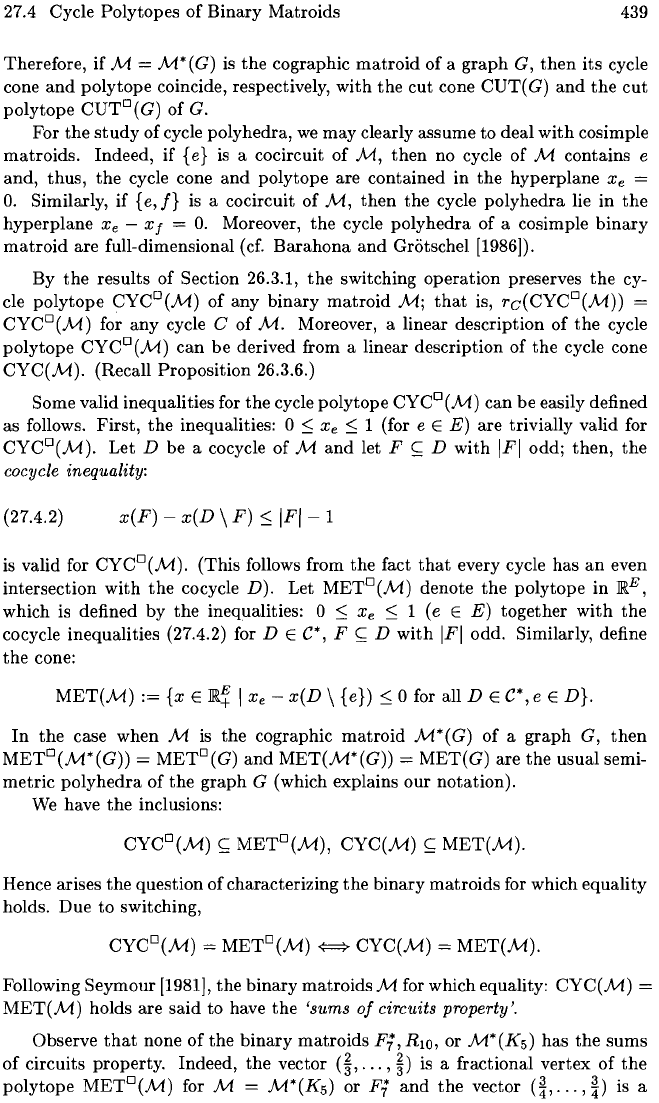
27.4 Cycle Polytopes
of
Binary Matroids
439
Therefore,
if M =
M*(G)
is
the
cographic
matroid
of
a
graph
G,
then
its cycle
cone
and
polytope coincide, respectively, with
the
cut
cone
CUT(
G)
and
the
cut
polytope
CUT
D
(G)
of
G.
For
the
study
of
cycle polyhedra,
we
may clearly assume to deal
with
cosimple
matroids. Indeed,
if {e}
is
a cocircuit
of
M,
then
no cycle
of
M contains e
and,
thus,
the
cycle cone
and
polytope are contained
in
the
hyperplane
Xe
=
o.
Similarly, if {e, J}
is
a cocircuit
of
M,
then
the
cycle
polyhedra
lie
in
the
hyperplane
Xe
-
xf
=
o.
Moreover,
the
cycle polyhedra of a cosimple
binary
matroid
are full-dimensional (cf.
Barahona
and
Grotschel [1986]).
By
the
results
of
Section 26.3.1,
the
switching
operation
preserves
the
cy-
cle
polytope
CYCD(M)
of
any binary
matroid
M;
that
is,
rc(CYCD(M))
=
CYCD(M)
for any cycle C
of
M.
Moreover, a linear description
of
the
cycle
polytope
CYCD(M)
can
be
derived from a linear description
of
the
cycle cone
CYC(M).
(Recall Proposition 26.3.6.)
Some valid inequalities for
the
cycle polytope
CYCD(M)
can be easily defined
as follows.
First,
the
inequalities: 0
:::;
Xe
:::;
1 (for e E
E)
are trivially valid for
CYCD(M).
Let
D be a cocycle of M
and
let F
~
D with
IFI
odd;
then,
the
cocycle inequality:
(27.4.2)
x(F)
-
x(D
\
F)
:::;
IFI
- 1
is
valid for
CYCD(M).
(This follows from
the
fact
that
every cycle has
an
even
intersection with
the
co cycle D). Let
METD(M)
denote
the
polytope
in
~E,
which is defined by
the
inequalities: 0
:::;
Xe
:::; 1
(e
E
E)
together
with
the
co cycle inequalities (27.4.2) for D E
C*,
F
~
D
with
IFI
odd. Similarly, define
the
cone:
MET(M)
:=
{x
E~!
I
Xe
-
x(D
\ {e})
:::;
0 for all
DE
C*,e
ED}.
In
the
case when M
is
the
cographic
matroid
M*(G)
of
a
graph
G,
then
METD(M*(G))
= METD(G)
and
MET(M*(G))
=
MET(G)
are
the
usual semi-
metric
polyhedra
of
the
graph
G (which explains
our
notation).
We
have
the
inclusions:
CYCD(M)
~
METD(M),
CYC(M)
~
MET(M).
Hence arises
the
question
of
characterizing
the
binary matroids for which equality
holds. Due
to
switching,
CYCD(M)
=
METD(M)
{=;>
CYC(M)
=
MET(M).
Following Seymour [1981],
the
binary matroids M for which equality:
CYC(M)
=
MET(M)
holds are
said
to have
the
'sums
of
circuits property'.
Observe
that
none
of
the
binary
matroids
F;,
RIO,
or M*(K5) has
the
sums
of
circuits property. Indeed,
the
vector
(~,
...
,
~)
is
a fractional vertex
of
the
polytope
METD(M)
for M = M*(K5) or
F;
and
the
vector
(~,
...
,~)
is a
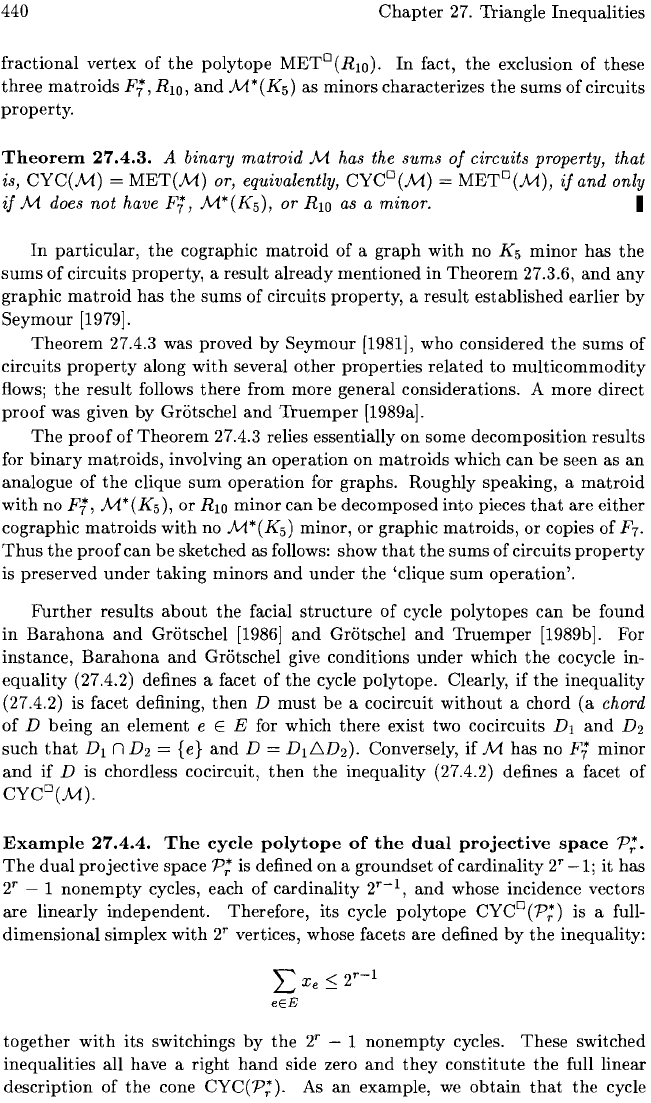
440
Chapter
27. Triangle Inequalities
fractional
vertex
of
the
polytope
METD(RlO).
In
fact,
the
exclusion of
these
three
matroids
F-i, R
lO
,
and
M*(K5)
as minors characterizes
the
sums
of
circuits
property.
Theorem
27.4.3.
A binary matroid M has the
sums
of
circuits property, that
is,
CYC(M)
=
MET(M)
or, equivalently,
CYCD(M)
=
METD(M),
if
and only
if
M does
not
have F-i,
M*(K
5
),
or
RlO
as
a minor. I
In
particular,
the
cographic
matroid
of a
graph
with
no K5
minor
has
the
sums
of
circuits property, a
result
already
mentioned
in
Theorem
27.3.6,
and
any
graphic
matroid
has
the
sums
of circuits property, a
result
established
earlier
by
Seymour
[1979].
Theorem
27.4.3 was proved
by
Seymour
[1981]' who considered
the
sums
of
circuits
property
along
with
several
other
properties
related
to
multicommodity
flows;
the
result
follows
there
from more general considerations. A
more
direct
proof
was given
by
Grotschel
and
Truemper
[1989a].
The
proof
of
Theorem
27.4.3 relies essentially
on
some decomposition
results
for
binary
matroids,
involving
an
operation
on
matroids
which
can
be
seen as
an
analogue of
the
clique
sum
operation
for graphs. Roughly speaking, a
matroid
with
no F-i,
M*(K
5
),
or
RlO
minor
can
be
decomposed into pieces
that
are
either
cographic
matroids
with
no
M*(K5)
minor, or graphic
matroids,
or copies of F
7
.
Thus
the
proof
can
be
sketched as follows: show
that
the
sums
of circuits
property
is preserved
under
taking
minors
and
under
the
'clique
sum
operation'.
Further
results
about
the
facial
structure
of
cycle
polytopes
can
be
found
in
Barahona
and
Griitschel
[1986]
and
Griitschel
and
Truemper
[1989b]. For
instance,
Barahona
and
Griitschel give conditions
under
which
the
co
cycle in-
equality
(27.4.2) defines a facet
of
the
cycle polytope. Clearly,
if
the
inequality
(27.4.2) is facet defining,
then
D
must
be
a
co
circuit
without
a chord
(a
chord
of
D
being
an
element e E E for which
there
exist two cocircuits
D1
and
D2
such
that
D1
n
D2
=
{e}
and
D = D
1
6D
2
).
Conversely,
if
M has no
F-i
minor
and
if
D is chordless cocircuit,
then
the
inequality (27.4.2) defines a facet
of
CYCD(M).
Example
27.4.4.
The
cycle
polytope
of
the
dual
projective
space
P;.
The
dual
projective space
P;
is defined
on
a groundset of
cardinality
2
r
-1;
it
has
2'
- 1
nonempty
cycles, each of
cardinality
2
r
-
1
,
and
whose incidence vectors
are linearly
independent.
Therefore, its cycle
polytope
CYCD(pn
is a full-
dimensional
simplex
with
2
r
vertices, whose facets are defined
by
the
inequality:
together
with
its switchings
by
the
2'
- 1
nonempty
cycles.
These
switched
inequalities all have a right
hand
side zero
and
they
constitute
the
full linear
description
of
the
cone
CyC(pn.
As
an
example,
we
obtain
that
the
cycle
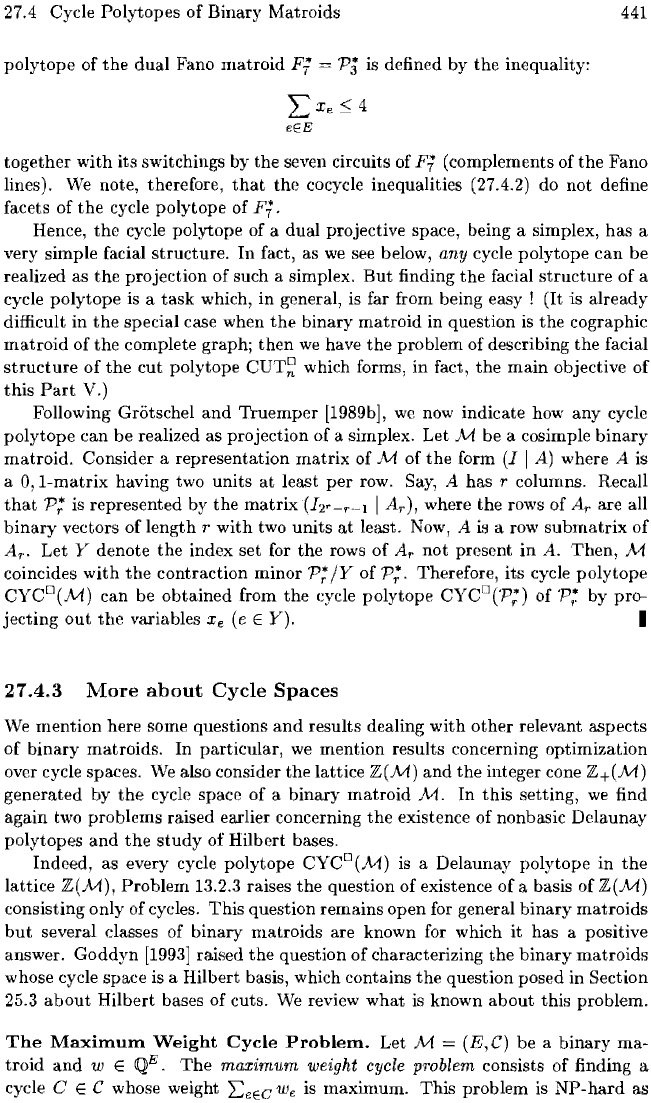
27.4 Cycle Polytopes of Binary Matroids
441
polytope of
the
dual Fano matroid
F;
=
Pi
is defined by the inequality:
together with its switchings by the seven circuits of
Pi
(complements of the Fano
lines).
We
note, therefore,
that
the cocycle inequalities (27.4.2) do not define
facets
of
the
cycle polytope
of
Hence,
the
cycle polytope of a dual projective space, being a simplex, has a
very simple facial structure.
In
fact, as
we
see below,
any
cycle polytope
can
be
realized as
the
projection
of
such a simplex.
But
finding the facial
structure
of a
cycle polytope is a task which, in general, is far from being
easy!
(It is already
difficult in
the
special case when the binary matroid in question is the cographic
matroid
of the complete graph; then
we
have the problem of describing the facial
structure
of
the
cut
polytope
CUT~
which forms, in fact, the main objective
of
this
Part
V.)
Following Grotschel
and
Truemper [1989b],
we
now indicate how any cycle
polytope can be realized as projection of a simplex. Let
M be a cosimple binary
matroid. Consider a representation
matrix
of
M
of
the
form
(1
I A) where A is
a 0,
I-matrix
having two units
at
least
per
row.
Say,
A has r columns. Recall
that
P;
is represented by the
matrix
(I2"-r--l I AT), where the rows of
AT
are all
binary
vectors of length r
with
two units
at
least.
Now,
A
is
a row
submatrix
of
AT' Let Y denote the index set for the rows
of
Ar
not present
in
A.
Then,
M
coincides
with
the
contraction minor
P;
/Y
of
P;.
Therefore,
its
cycle polytope
CYCD(M)
can be obtained from
the
cycle polytope
CYCD(P;)
of
P;
by pro-
jecting
out
the
variables
Xe
(e
E Y). I
27.4.3
More
about
Cycle
Spaces
We
mention here some questions
and
results dealing with other relevant aspects
of
binary matroids.
In
particular,
we
mention results concerning optimization
over cycle spaces.
We
also consider the lattice
Z(M)
and the integer cone
Z+(M)
generated by
the
cycle space of a binary matroid
M.
In
this setting,
we
find
again two problems raised earlier concerning
the
existence of nonbasic Delaunay
polytopes
and
the
study
of Hilbert bases.
Indeed, as every cycle polytope CYCD(M)
is
a Delaunay polytope in
the
lattice
Z(M),
Problem 13.2.3 raises the question of existence of a basis of
Z(M)
consisting only of cycles. This question remains open
for
general binary matroids
but
several classes of binary matroids are known for which
it
has a positive
answer. Goddyn
[1993]
raised the question of characterizing the
binary
matroids
whose cycle space is a Hilbert basis, which contains the question posed
in
Section
25.3
about
Hilbert bases of cuts.
We
review what is known
about
this problem.
The
Maximum
Weight
Cycle
Problem.
Let
A1
=
(E,C)
be a
binary
ma-
troid
and
W E
Ql.
The
maximum weight cycle problem consists of finding a
cycle
C E C whose weight
We
is maximum. This problem is
NP-hard
as
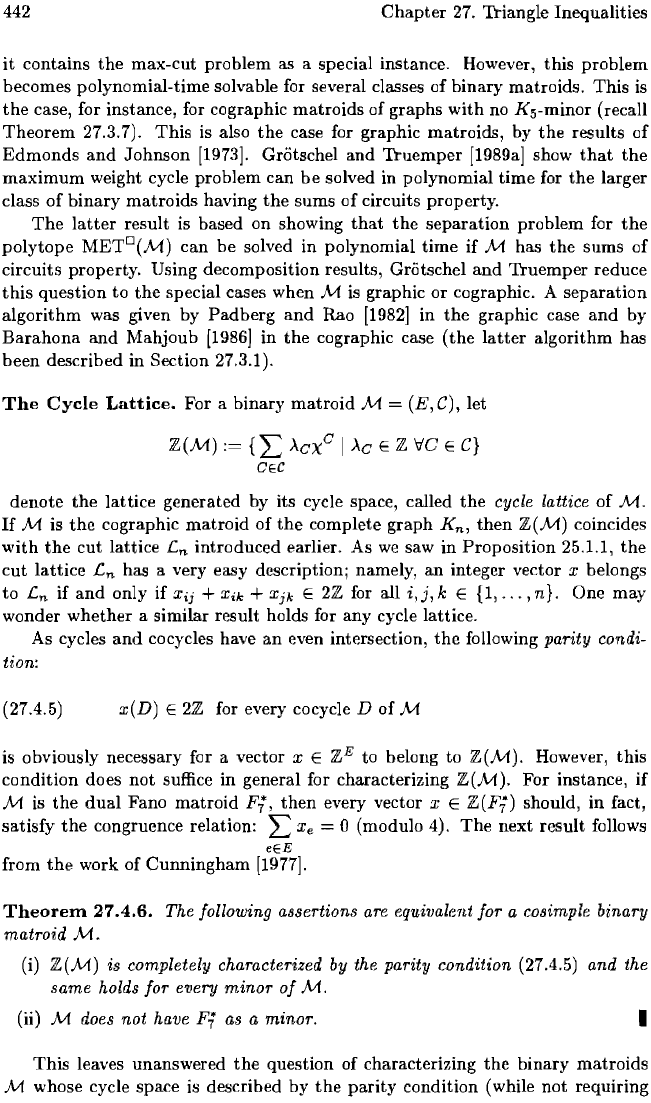
442
Chapter
27.
Triangle Inequalities
it
contains
the
max-cut problem as a special instance. However,
this
problem
becomes polynomial-time solvable for several classes
of
binary matroids. This is
the
case, for instance, for cographic matroids
of
graphs
with
no K5-minor (recall
Theorem 27.3.7).
This
is also
the
case for graphic matroids, by
the
results
of
Edmonds
and
Johnson
[1973].
Griitschel and Truemper [1989a] show
that
the
maximum
weight cycle problem
can
be
solved in polynomial time for
the
larger
class
of
binary matroids having
the
sums
of
circuits property.
The
latter
result is based on showing
that
the
separation problem for
the
polytope
MET
O
(}'-1)
can be solved
in
polynomial
time
if
M has
the
sums
of
circuits property. Using decomposition results, Griitschel
and
Truemper reduce
this
question to the special cases when M is graphic
or
cographic. A separation
algorithm was given by Padberg
and
Rao
[1982]
in
the
graphic case
and
by
Barahona
and
Mahjoub
[1986]
in
the
cographic case (the
latter
algorithm has
been described
in
Section 27.3.1).
The
Cycle
Lattice.
For a binary
matroid
M = (E,
C),
let
Z(M)
{L
>'CX
c
I
>'c
E Z ve E
C}
CEe
denote
the
lattice generated by
its
cycle space, called
the
cycle lattice of
}'-1.
If
M is
the
cographic
matroid
of
the
complete graph K
n
,
then
Z(M)
coincides
with
the
cut
lattice
en
introduced earlier. As
we
saw
in
Proposition 25.1.1,
the
cut
lattice
en
has a very easy description; namely, an integer vector x belongs
to
en
if
and
only
if
Xij
+
Xik
+
Xjk
E 2Z for all
i,j,
k E
{I,
...
,
n}.
One may
wonder whether a similar result holds for any cycle lattice.
As cycles
and
co
cycles have
an
even intersection,
the
following parity condi-
tion:
(27.4.5)
x(D)
E 2Z for every cocycle D
of
M
is obviously necessary for a vector x E
ZE
to belong to
Z(M).
However,
this
condition does not suffice in general for characterizing
Z(M).
For instance,
if
M is
the
dual
Fano matroid
F;,
then
every vector x E
Z(F;)
should, in fact,
satisfy
the
congruence relation: L
Xe
= 0 (modulo 4).
The
next result follows
eEE
from
the
work
of
Cunningham
[1977].
Theorem
27.4.6.
The following assertions
are
equivalent for a cosimple binary
matroid
M.
(i)
Z(M)
is completely characterized by the parity condition (27.4.5) and the
same holds for every
minor
of
M.
(ii) M does
not
have
F;
as
a minor.
I
This
leaves unanswered
the
question of characterizing the binary matroids
M whose cycle space is described by
the
parity condition (while not requiring
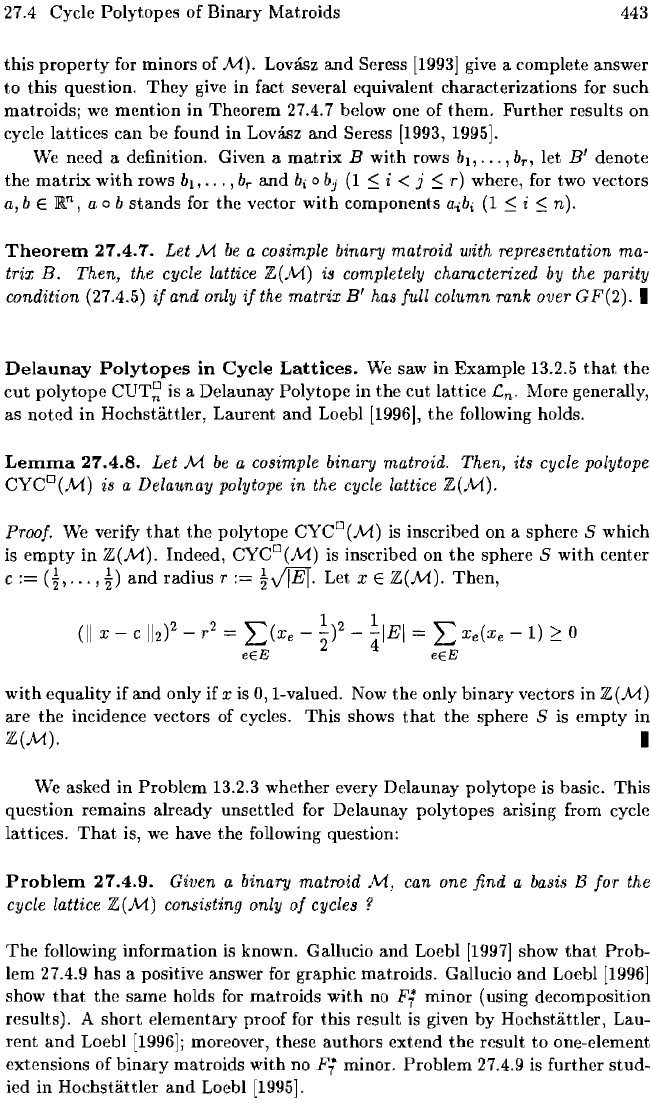
27.4 Cycle Polytopes
of
Binary Matroids
443
this
property
for minors of
M).
Lovasz
and
Seress
[1993]
give a complete answer
to
this question.
They
give in fact several equivalent characterizations for such
matroidsj
we
mention
in
Theorem 27.4.7 below one
of
them.
Further
results on
cycle lattices
can
be
found in Lovasz
and
Seress [1993, 1995].
We
need a definition. Given a
matrix
B
with
rows bI, .
..
,
bTl
let
B'
denote
the
matrix
with
rows b
i
,
...
,b
r
and
bi
0
bj
(1
~
i < j
~
r) where, for two vectors
a,
bE
]Rn, a 0 b
stands
for the vector
with
components aibi
(1
~
i
~
n).
Theorem
27.4.7.
Let M
be
a cosimple binary matroid with representation ma-
trix
B.
Then, the cycle lattice Z(A1) is completely characterized by the parity
condition
(27.4.5)
if
and only
if
the
matrix
B'
has full column rank over G
F(2).
I
Delaunay
Polytopes
in
Cycle
Lattices.
We
saw
in
Example 13.2.5
that
the
cut
polytope
GlJT~
is a Delaunay Polytope
in
the
cut
lattice Ln. More generally,
as
noted
in Hochstattler, Laurent
and
Loebl [1996],
the
following holds.
Lemma
27.4.S.
Let
M
be
a cosimple binary matroid. Then, its cycle polytope
CYCD(M)
is a Delaunay polytope in the cycle lattice Z(.A1).
Proof.
We
verify
that
the polytope CYCD(M) is inscribed on a sphere S which
is
empty
in
Z(M).
Indeed, CYCD(M) is inscribed on
the
sphere S
with
center
c
a,
...
,
t)
and
radius r
:=
tJlET·
Let x E
Z(M).
Then,
with
equality
if
and
only
if
x is
0,
I-valued.
Now
the only binary vectors in
Z(M)
are
the incidence vectors of cycles. This shows
that
the
sphere S is
empty
in
Z(M).
I
We
asked
in
Problem 13.2.3 whether every Delaunay polytope is basic. This
question remains already unsettled for Delaunay polytopes arising from cycle
lattices.
That
is,
we
have the following question:
Problem
27.4.9.
Given a binary matroid
."'1,
can one find a basis B for the
cycle lattice
Z(M)
consisting only
of
cycles?
The
following information is known. Gal1ucio
and
Loebl
[1997]
show
that
Prob-
lem 27.4.9 has a positive answer for graphic matroids. Gallucio
and
Loeb!
[1996]
show
that
the
same holds
for
matroids with no minor (using decomposition
results). A
short
elementary proof for this result is given
by
Hochstattler, Lau-
rent
and
Loebl
[19961;
moreover, these authors extend
the
result
to
one-element
extensions of
binary
matroids with no Pi minor. Problem 27.4.9 is further stud-
ied
in
Hochstattler
and
Loebl
[1995].
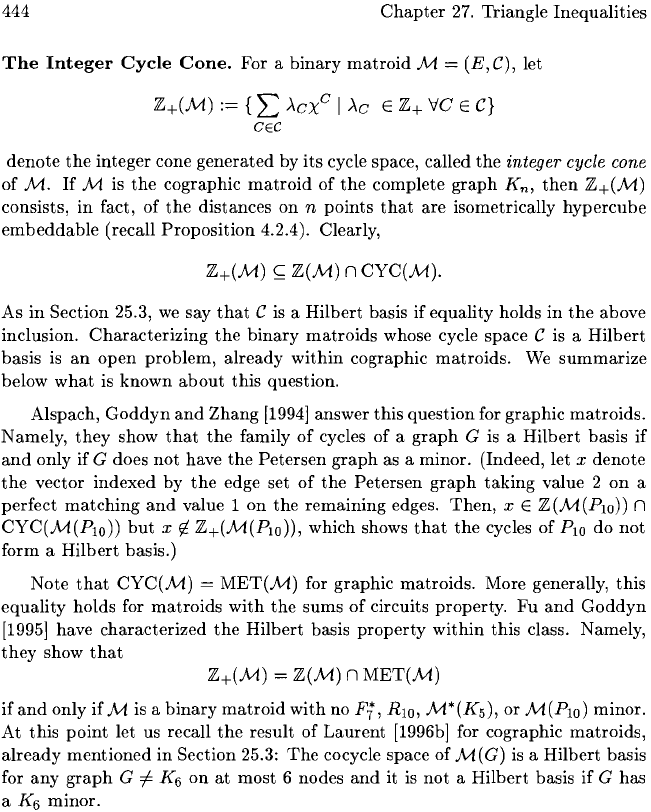
444
Chapter
27.
Triangle
Inequalities
The
Integer
Cycle
Cone.
For a
binary
matroid
M = (E,C), let
Z+(M):=
{l::
ACX
C
I
AC
E
Z+
'Ie E
C}
CEe
denote
the
integer
cone
generated
by
its
cycle space, called
the
integer cycle cone
of
M.
If
M is
the
cographic
matroid
of
the
complete
graph
K
n
,
then
Z+(M)
consists,
in
fact,
of
the
distances
on
n
points
that
are
isometrically
hypercube
embeddable
(recall
Proposition
4.2.4). Clearly,
Z+(M)
<;::;
Z(M)
n
CYC(M).
As
in
Section
25.3,
we
say
that
C is a
Hilbert
basis if
equality
holds
in
the
above
inclusion.
Characterizing
the
binary
matroids
whose cycle space C is a
Hilbert
basis
is
an
open
problem,
already
within
cographic
matroids.
We
summarize
below
what
is
known
about
this
question.
Alspach,
Goddyn
and
Zhang
[1994]
answer
this
question
for
graphic
matroids.
Namely,
they
show
that
the
family
of
cycles
of
a
graph
G is a
Hilbert
basis
if
and
only
if
G does
not
have
the
Petersen
graph
as a minor. (Indeed,
let
x
denote
the
vector
indexed
by
the
edge
set
of
the
Petersen
graph
taking
value 2
on
a
perfect
matching
and
value 1
on
the
remaining
edges.
Then,
x E
Z(M(P
lO
))
n
CYC(M(PIO))
but
x
if.
Z+(M(P
lO
)),
which shows
that
the
cycles
of
PIO
do
not
form a
Hilbert
basis.)
Note
that
CYC(M)
=
MET(M)
for
graphic
matroids.
More generally,
this
equality
holds
for
matroids
with
the
sums
of
circuits property. Fu
and
Goddyn
[1995] have
characterized
the
Hilbert
basis
property
within
this
class. Namely,
they
show
that
Z+(M)
=
Z(M)
n
MET(M)
if
and
only
if
M is a
binary
matroid
with
no
F;,
RIO,
M*(K5),
or
M(PIO)
minor.
At
this
point
let
us recall
the
result
of
Laurent
[1996b] for cographic
matroids,
already
mentioned
in
Section
25.3:
The
co cycle space
of
M(G)
is a
Hilbert
basis
for
any
graph
G
i-
K6
on
at
most
6 nodes
and
it
is
not
a
Hilbert
basis
if
G
has
a
K6
minor.
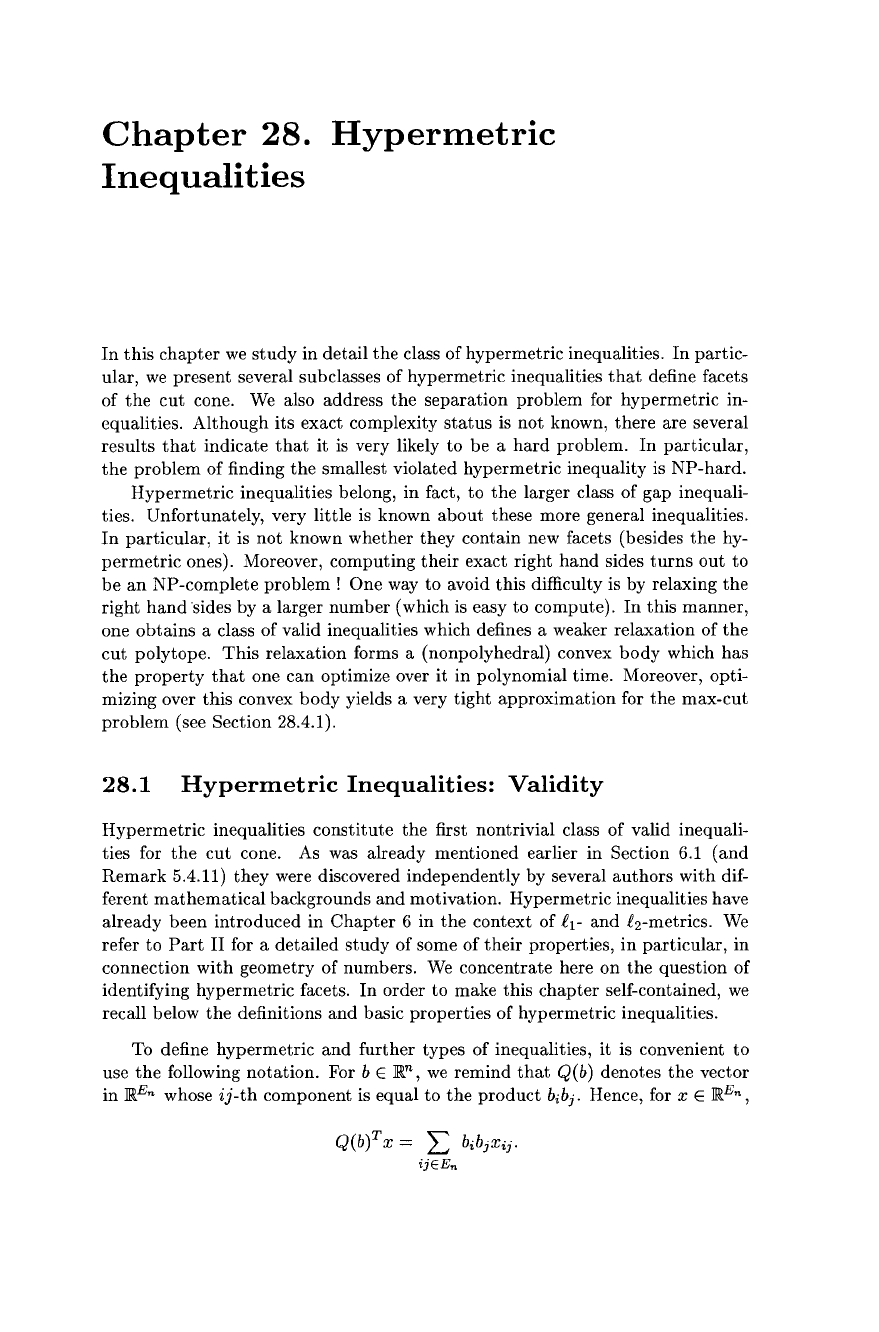
M.M. Deza, M. Laurent, Geometry of Cuts and Metrics, Algorithms and Combinatorics 15,
DOI 10.1007/978-3-642-04295-9_28, © Springer-Verlag Berlin Heidelberg 2010
Chapter
28.
Hypermetric
Inequalities
In
this
chapter
we
study
in
detail
the
class of
hypermetric
inequalities.
In
partic-
ular,
we
present several subclasses of
hypermetric
inequalities
that
define facets
of
the
cut
cone. We also address
the
separation
problem for
hypermetric
in-
equalities.
Although
its
exact complexity
status
is not known, there are several
results
that
indicate
that
it
is
very likely to be a
hard
problem.
In
particular,
the
problem
of finding
the
smallest violated
hypermetric
inequality is
NP-hard.
Hypermetric
inequalities belong,
in
fact, to
the
larger class of
gap
inequali-
ties. Unfortunately, very little
is
known
about
these more general inequalities.
In
particular,
it
is not known whether
they
contain new facets (besides
the
hy-
permetric
ones). Moreover, computing
their
exact right
hand
sides
turns
out
to
be
an
NP-complete
problem!
One way to avoid this difficulty is by relaxing
the
right
hand
·sides by a larger
number
(which is easy to compute).
In
this
manner,
one
obtains
a class of valid inequalities which defines a weaker relaxation of
the
cut
polytope.
This
relaxation forms a (nonpolyhedral) convex
body
which has
the
property
that
one
can
optimize over it
in
polynomial time. Moreover, opti-
mizing over this convex
body
yields a very
tight
approximation
for
the
max-cut
problem
(see Section 28.4.1).
28.1
Hyperrnetric
Inequalities:
Validity
Hypermetric
inequalities
constitute
the
first nontrivial class of valid inequali-
ties for
the
cut
cone. As was already mentioned earlier
in
Section 6.1
(and
Remark
5.4.11)
they
were discovered independently by several
authors
with
dif-
ferent
mathematical
backgrounds
and
motivation.
Hypermetric
inequalities have
already
been
introduced
in
Chapter
6
in
the
context of
£1-
and
£2-metrics. We
refer
to
Part
II
for a detailed
study
of
some
of
their
properties,
in
particular,
in
connection
with
geometry of numbers. We concentrate here
on
the
question of
identifying
hypermetric
facets.
In
order to make this
chapter
self-contained,
we
recall below
the
definitions
and
basic properties of hypermetric inequalities.
To define
hypermetric
and
further types
of
inequalities, it is convenient
to
use
the
following notation. For b E
llt
n
,
we
remind
that
Q(b) denotes
the
vector
in
llt
En
whose
ij-th
component
is
equal
to
the
product
bib
j
.
Hence, for x E
llt
En
,
Q(bf
x = L bibjX;j.
ijEEn
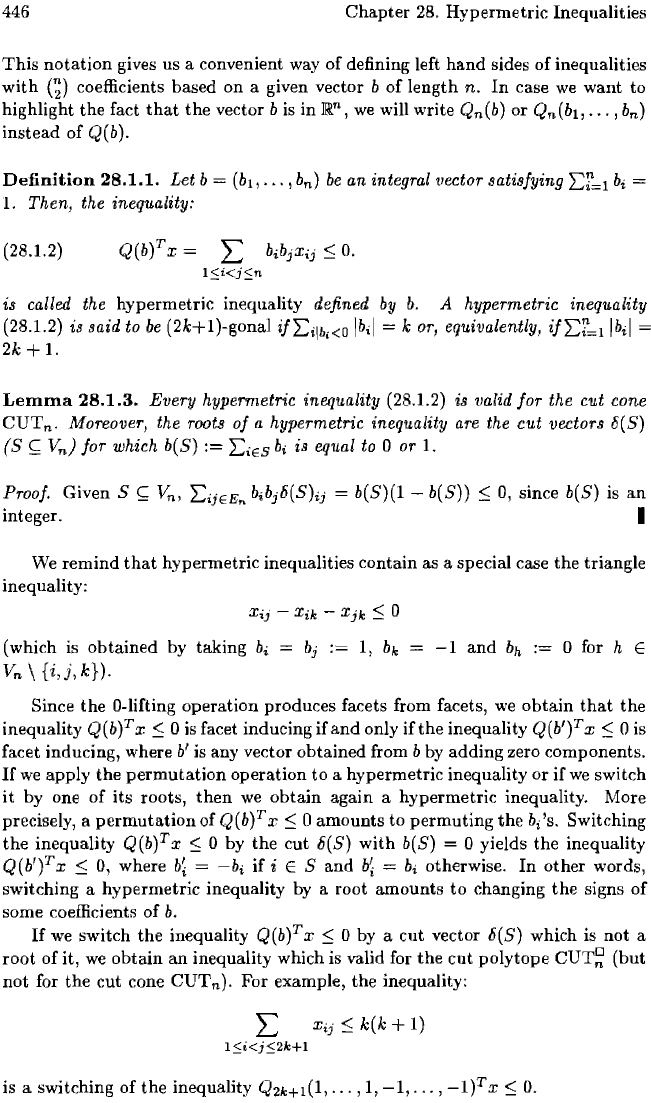
446
Chapter
28. Hypermetric Inequalities
This
notation
gives us a convenient way
of
defining left
hand
sides
of
inequalities
with
G)
coefficients based on a given vector b
of
length n.
In
case
we
want to
highlight the fact
that
the vector b
is
in]Rn,
we
will write Qn(b) or Qn(bl,
...
,
bn)
instead of Q(b).
Definition
28.1.1.
Let b =
(b
1j
•••
,b
n
)
be
an
integral vector satisfying Ei",1
bi
=
1. Then, the inequality:
(28.1.2) Q(b)T X = L bibjXij
~
O.
19<j:5n
is called the
hypermetric inequality defined
by
b.
A hypermetric inequality
(28.1.2) is said to
be
(2k+l)-gonal
if
Eilbi<O
Ibil
= k
or,
equivalently,
ifEi=1
Ibil
=
2k
+ 1.
Lemma
28.1.3.
Every hypermetric inequality (28.1.2) is valid for the cut cone
CUT
n
.
Moreover, the
roots
of
a hypermetric inequality
are
the cut vectors 6(S)
(S
<;-;
V
n
) for which b(S)
bi
is equal
to
0 or 1.
Proof. Given S
<;-;
V
n
,
integer.
bibjo(S)';j b(S)(1 -
b(S»
~
0, since b(S) is
an
I
We
remind
that
hypermetric inequalities contain as a special case the triangle
inequality:
(which is obtained by taking
bi
=
bj
:=
1,
bk
=
-1
and
bh
:=
0 for h E
Vn
\
{i,j,k}).
Since the O-lifting operation produces facets from facets,
we
obtain
that
the
inequality
Q(b)T x
~
0
is
facet inducing if
and
only if the inequality
Q(bll
x
~
0 is
facet inducing, where
b
'
is any vector obtained from b
by
adding zero components.
If
we
apply
the
permutation
operation to a hypermetric inequality or if
we
switch
it
by one
of
its
roots,
then
we
obtain again a hypermetric inequality. More
precisely, a
permutation
of
Q(b)T x
~
0 amounts to permuting the
b;'s.
Switching
the
inequality Q(b)T x
~
0 by
the
cut
o(S)
with
b(S) 0 yields the inequality
Q(b')T x
~
0, where
b~
=
-bi
if
i E S and
~
=
bi
otherwise.
In
other words,
switching a hypermetric inequality
by
a root amounts
to
changing
the
signs
of
some coefficients
of
b.
If
we
switch the inequality
Q(bl
x
~
0 by a
cut
vector O(S) which is not a
root
of it,
we
obtain
an
inequality which is valid for the
cut
polytope
CUT~
(but
not for the cut cone
CUT
n). For example, the inequality:
L
Xij
~
k(k+
1)
1
:5i<j
:S2k+l
is a switching of the inequality
Q21<:+1(1,
...
, 1,
-1,
...
,
-l)T
x
~
O.
